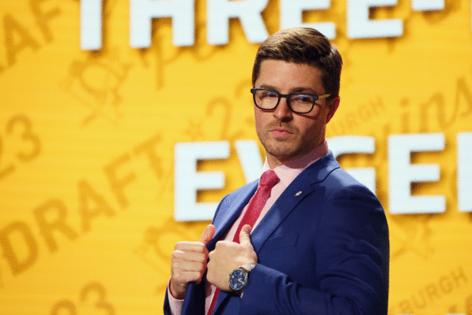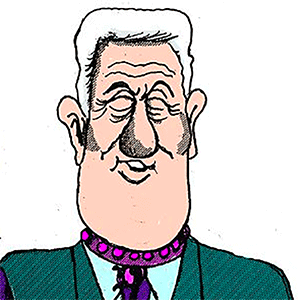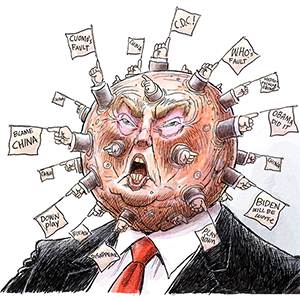Jason Mackey: High marks for Kyle Dubas, who made precisely the type of trade the Penguins need
Published in Hockey
PITTSBURGH — Excuse me, Kyle Dubas did what?
In case you missed it, the Penguins president of hockey operations made a smart and sizable swap overnight Friday, sending Marcus Pettersson and Drew O'Connor to the Vancouver Canucks for Danton Heinen, Vincent Desharnais, prospect Melvin Fernstrom and a conditional 2025 first-round pick.
We knew Dubas was going to deal Pettersson and perhaps O'Connor, too, the result of both being on expiring contracts.
The return is far better than I'm guessing most of us expected.
It's an example of Dubas threading a needle to solve the tricky situation in which the Penguins find themselves: rife with no-movement clauses, short on moveable players when it comes to those without no-movement clauses, and an organizational edict to retool or reload as quickly as possible.
Dubas crushed this trade.
He also might've preyed on a pair of desperate teams in the New York Rangers and Canucks, who hooked up earlier Friday in a swap involving J.T. Miller.
The pick is top-13 protected and would shift to 2026 if that happens, but I view that a few different ways.
— Perhaps the Rangers (6-2-2 in their last 10) can figure themselves out and avoid the top 13. Or ...
— It's not exactly the worst thing to keep accumulating picks the way Dubas has, hit on them and create a world in which the Penguins achieve more sustainability on the far end of Sidney Crosby's time here.
— Meanwhile, the pick also doubles as capital for another possible transaction. That could really matter with Friday's news that the NHL salary cap will jump from $88 million in 2024-25 to $95.5 million in 2025-26 and $104 million the following season.
Dubas will soon have more financial wiggle room to execute his plan. A first-round pick provides the same on the trade end of things.
Bottom line, it was a smart, cupboard-stocking swap for Dubas, as he moved on from a pair of players who haven't exactly had banner years.
Pettersson, for example, has produced a goals-for percentage during 5-on-5 play of 47.96, down from 56.49 a year ago and the worst of his career. He's also a career-worst minus-2 after finishing as a plus-28 in 2023-24.
But that's not a criticism of Pettersson. I think he's been influenced by circumstances, an inconsistent defense partner and shoddy goaltending more than anything. I was on the beat when the Penguins acquired him for Daniel Sprong, and it's been fun to watch Pettersson grow as a person, player and leader.
He arrived as a quiet kid weighing about 120 pounds soaking wet. He leaves as a top-four mainstay, a husband and father and genuine team leader who now weighs a solid 130 or 140 pounds. (I kid, I kid.)
But Pettersson wasn't going to stay here. He was in the final season of a five-year contract that paid him an average of just over $4 million. A raise was coming. The Penguins have other needs. Here's hoping Pettersson can help the Canucks steady their season.
O'Connor was supposed to build on a strong finish to the 2023-24 campaign, during which he scored 10 goals and produced 16 points in his final 27 games. That did not happen.
O'Connor was a minus-14 and endured a lengthy goal-scoring drought (32 games) earlier this year. His production could be replicated by Heinen — or not. Neither outcome will drastically tip the boat.
We know Heinen. He played in Pittsburgh from 2021-23 and has some skill, the 29-year-old amassing a career-high 18 goals in 2021-22 and enduring a few red-hot stretches. He's also prone to disappearing acts, much like other parts of the Penguins' roster.
Again, we'll see. Could help. Could be the same. But the parts I'm circling here are the first-round pick and Fernstrom, an 18-year-old Swede that Vancouver grabbed in the third round of last year's NHL draft.
Currently in the Swedish Hockey League, Fernstrom has offensive upside and widens the Penguins' pool of forward prospects that already includes Rutger McGroarty, Ville Koivunen, Vasily Ponomarev, Cruz Lucius, Tristan Broz and others.
In other words, Fernstrom isn't exactly a throw-in.
I'm also intrigued by Desharnais, who's certainly different than anything the Penguins currently have — and I mean that in a good way.
He's a right shot, so he'll slot behind Kris Letang and Erik Karlsson. He's also 6-foot-7, 226 pounds and looks like the villain in an action movie involving Russian gangsters. Let's hope he plays just as mean.
In Edmonton, Desharnais logged 28 playoff games between 2022-24. Last season with the Edmonton Oilers, he was responsible for 6.60 hits per 60 minutes of ice time and 5.96 blocked shots per 60 — marks that would've been first or second among Penguins qualifiers. His opportunity should be different here.
As much as we'd all rather see the Penguins make some sort of (unrealistic) playoff push, this has become the new normal, deals that reposition the Penguins for next season and beyond. The trick will be to execute them swiftly and correctly, creating a base layer that was so fundamental to the Penguins' previous success.
This deal wasn't Dubas forcing something because he felt like he had to. It was acquiring a couple different things that fit within the team's current scope of needs.
It's hard to dislike that.
© 2025 the Pittsburgh Post-Gazette. Visit www.post-gazette.com. Distributed by Tribune Content Agency, LLC.







Comments